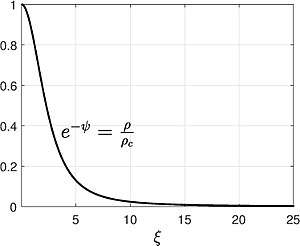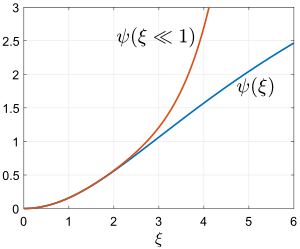Emden–Chandrasekhar equation
In astrophysics, the Emden–Chandrasekhar equation is a dimensionless form of the Poisson equation for the density distribution of a spherically symmetric isothermal gas sphere subjected to its own gravitational force, named after Robert Emden and Subrahmanyan Chandrasekhar.[1][2] The equation was first introduced by Robert Emden in 1907.[3] The equation[4] reads

where is the dimensionless radius and is the related to the density of the gas sphere as , where is the density of the gas at the centre. The equation has no known explicit solution. If a polytropic fluid is used instead of an isothermal fluid, one obtains the Lane–Emden equation. The isothermal assumption is usually modeled to describe the core of a star. The equation is solved with the initial conditions,
The equation appears in other branches of physics as well, for example the same equation appears in the Frank-Kamenetskii explosion theory for a spherical vessel. The relativistic version of this spherically symmetric isothermal model was studied by Subrahmanyan Chandrasekhar in 1972[5].
Derivation
For an isothermal gaseous star, the pressure is due to the kinetic pressure and radiation pressure
where
- is the density
- is the Boltzmann constant
- is the mean molecular weight
- is the mass of the proton
- is the temperature of the star
- is the Stefan–Boltzmann constant
- is the speed of light
The equation for equilibrium of the star requires a balance between the pressure force and gravitational force
where is the radius measured from the center and is the gravitational constant. The equation is re-written as

Introducing the transformation
where is the central density of the star, leads to
The boundary conditions are
For , the solution goes like
Limitations of the model
Assuming isothermal sphere has some disadvantages. Though the density obtained as solution of this isothermal gas sphere decreases from the centre, it decreases too slowly to give a well-defined surface and finite mass for the sphere. It can be shown that, as ,
where and are constants which will be obtained with numerical solution. This behavior of density gives rise to increase in mass with increase in radius. Thus, the model is usually valid to describe the core of the star, where the temperature is approximately constant.[6]
Singular solution
Introducing the transformation transforms the equation to
The equation has a singular solution given by
Therefore, a new variable can be introduced as , where the equation for can be derived,
This equation can be reduced to first order by introducing
then we have
Properties
- If is a solution to Emden–Chandrasekhar equation, then is also a solution of the equation, where is an arbitrary constant.
- The solutions of the Emden–Chandrasekhar equation which are finite at the origin have necessarily at
References
- Chandrasekhar, Subrahmanyan, and Subrahmanyan Chandrasekhar. An introduction to the study of stellar structure. Vol. 2. Courier Corporation, 1958.
- Chandrasekhar, S., and Gordon W. Wares. "The Isothermal Function." The Astrophysical Journal 109 (1949): 551-554.http://articles.adsabs.harvard.edu/cgi-bin/nph-iarticle_query?1949ApJ...109..551C&defaultprint=YES&filetype=.pdf
- Emden, R. (1907). Gaskugeln: Anwendungen der mechanischen Wärmetheorie auf kosmologische und meteorologische Probleme. B. Teubner..
- Kippenhahn, Rudolf, Alfred Weigert, and Achim Weiss. Stellar structure and evolution. Vol. 282. Berlin: Springer-Verlag, 1990.
- Chandrasekhar, S. (1972). A limiting case of relativistic equilibrium. In General Relativity (in honor of J. L. Synge), ed. L. O'Raifeartaigh. Oxford. Clarendon Press (pp. 185-199).
- Henrich, L. R., & Chandrasekhar, S. (1941). Stellar Models with Isothermal Cores. The Astrophysical Journal, 94, 525.